|
Click pictures for a larger version.
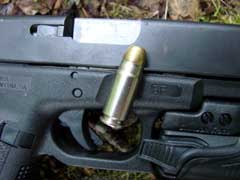
The 9x25mm Dillon cartridge.
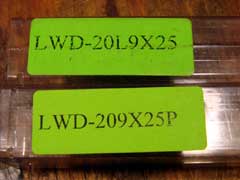
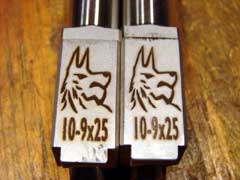
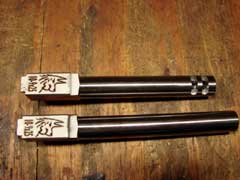
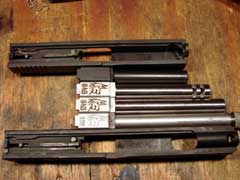
Lone Wolf conversion barrels.
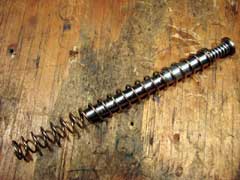
DPM recoil-reducing guide rod system.
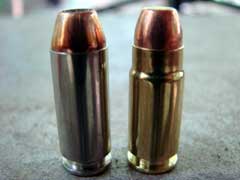
9x25mm Dillon cartridge (right) compared to parent 10mm
cartridge (left).
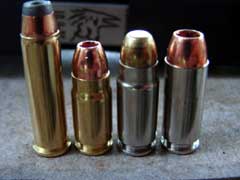
Left to right; 357 Magnum, 357 Sig, 9x25 Dillon, 10mm Auto.
|
|
The 9x25mm Dillon cartridge has been around
for about a quarter century. The cartridge was developed for
competition use, and is simply the 10mm Auto
case necked down to accept a 9mm bullet. The 9x25 is to the 10mm
as the 357 Sig is to the 40 S&W. The latter case is a
shorter version of the original 10mm, and both the 40 S&W
and the 357 Sig are more popular today than their 10mm
predecessor.
With manufacturers of firearms introducing
more powerful revolver cartridges in recent years, and the
shooting public’s acceptance of these new cartridges, it would
seem that shooters of auto-pistols would welcome more power as
well, but that does not seem to be the case, if firearm sales
are an indicator. The popular 500 and 460
S&W magnums, the 500
Wyoming Express, 454
Casull, 475 & 500
Linebaugh, and other powerful revolver cartridges are more
popular now than ever, but when it comes to cartridges for
auto-pistols, the buyers are just not flocking towards the
excellent 10mm, nor its offspring, the 9x25 Dillon.
High-performance ammunition is readily
available for both cartridges. You are not going to run down to
Wal-Mart and buy a box of 9x25, nor even a box of 10mm, but
excellent ammunition is available online. I have written about
the 10mm a few times before, so here we are looking at the 9x25
Dillon, and the advantages that the cartridge has over is weaker
competitors.
One disadvantage that presents itself to most
shooters is that the 9x25 is not currently chambered in any
production pistol that is available off the shelf at your local
gun dealer. While most well-stocked gun stores have plenty of 40
S&W and 357 Sig pistols available, the 10mm pistols will be
scarce, and the 9x25 pretty much unavailable. However,
converting a 10mm pistol to 9x25 Dillon is as easy as swapping
the barrel. Lone Wolf Distributors has 9x25 Dillon barrels in
stock and ready to ship for a simple swap in a 10mm Glock
pistol. For 1911 users, Bar-Sto can supply a 9x25 Dillon barrel.
The 9x25mm uses standard 10mm magazines, slides, extractors, and
other parts, so the barrel is all that is needed to make the
switch.
The 9x25 Dillon offers a significant velocity
advantage over the 357 Sig, and gives 357 magnum performance out
of a high-capacity auto-pistol. My favorite pistol for the
conversion is a Glock Model 20SF. The Model 20SF is a reliable
and affordable 10mm pistol, and the barrels for the conversion
are easy to get and relatively inexpensive. Lone Wolf has
barrels available in standard and extended lengths, and they
also have a long slide available, for those who do not want an
extended barrel protruding from the front of the slide.
The 9x25mm is a cartridge which, like most
others, benefits from a longer-than-standard barrel length. The
cartridge was developed to provide a fast-shooting cartridge to
work well in compensated auto-pistols for ISPC competition, and
in that role, it achieved its goal. However, it is not necessary
to use the 9x25 to make major power in ISPC, and for that role,
there are other cartridges which do just as well. I like the
9x25 for its flat-shooting power for use as a hunting and
fighting pistol, and those is the applications which we will
look at here.
The 357 magnum cartridge is well-established
as a fight stopper and as a cartridge for taking whitetail deer
and hogs. The 9x25 pushes a bullet that is very close to the
diameter of the 357 magnum at the same nominal speeds, so the
performance would be expected to be the same. For hunting, I
prefer the lead-free hollowpoint bullets that are available from
Barnes as the XPB, or one of the tougher hollowpoint
cup-and-core bullets. For social work, these same bullets are
great choices. Most any of the expanding bullets loaded
commercially by Double Tap or by Underwood would be good choices
for social work, but I prefer the heavier weights for deer and
especially for hogs.
I fired every type of commercially-loaded
ammunition for the 9x25 Dillon that I could find, to check
velocities from two Lone Wolf barrels; one a six-inch non-ported
barrel, and the other a five and one-half inch ported.
Velocities were checked at a distance of twelve feet from the
muzzle. Temperature at the range during testing hovered around
the eighty-two degree Fahrenheit mark. Humidity was eighty-five
percent. Range elevation was approximately 541 feet above sea
level. FMJ is a full-metal-jacket bullet. JHP is a jacketed
hollowpoint. HC is a hard-cast lead bullet. CE is a controlled
expansion jacketed bullet. Velocities are listed in
feet-per-second (FPS). Bullet weights are listed in grains.
| Ammunition |
Bullet
Weight |
Velocity
6.02" |
Velocity
5.47" Ported |
| Double Tap
FMJ |
95 |
1937 |
1853 |
| Double Tap
CE |
95 |
1945 |
1866 |
| Double Tap
FMJ |
125 |
1611 |
1540 |
| Double Tap
JHP |
125 |
1597 |
1550 |
| Double Tap
FMJ |
147 |
1301 |
1261 |
| Double Tap
HC |
180 |
1212 |
1153 |
| Underwood JHP |
125 |
1670 |
1619 |
| Underwood FMJ |
125 |
1698 |
1635 |
The velocities recorded were rather
impressive, besting velocities from a 357 Sig by a significant
margin. The 357 Sig is a dandy cartridge, but the 9x25 does
everything that the 357 Sig does, and shoots flatter and hits
harder. Velocities from the ported barrel show a marked decrease
under the velocities of the six inch. The 5.47 inch ported
barrel is effectively closer to a five inch, as the ported
section adds no velocity. Also, the ported barrel had a much
greater amount of muzzle flash from the shooter’s viewpoint,
and for that reason, I do not like a ported barrel on a fighting
pistol, as after the first shot in low light, the shooter is
effectively temporarily blinded by the muzzle flash. The six
inch barrel shown will work equally well in a standard or long
slide, and is the best choice for a hunting barrel for the 9x25.
For carry, I would get a standard 4.6 inch barrel length, and
the results should be close in velocity to those of the 5.47
inch ported, without the muzzle flash. Accuracy was very good,
with both barrels being capable of turning in match-grade
performance from a distance of twenty-five yards, secured into a
Ransom Master Series machine rest.
The justification for the existence of the
9x25mm Dillon as a defensive and hunting cartridge must be in
how it compares to its competition, being mainly the 357 magnum
revolver cartridge, and the 357 Sig and 10mm auto-pistol
cartridges. As a hunting cartridge, the 9x25 has no advantage
over the 357 magnum revolver, as its greater capacity of
cartridges in the firearm is not a very important factor, at
least in whitetail hunting. If caught on the ground among a
group of wild hogs, the extra rounds might be needed, but in
most cases, they would not. In a gunfight, having sixteen rounds
available without reloading as opposed to only six or seven
could be very important. Compared to the 357 Sig cartridge, the
9x25mm is superior in both hunting and fighting situations, as
it is basically the same bullet, moving faster, offering better
penetration and higher impact velocities, with the proper bullet
choice. Recoil is a bit more than that of the 357 Sig, but not
enough to matter, in my opinion, and the weapon is much more
controllable than a 357 magnum revolver of equal weight. The
9x25mm Dillon is easy to handle in the Glock 20 platform.
Compared to the 10mm Auto cartridge, which is
better is a hard call. The weapon is identical in both handling,
size, capacity, and weight, so it comes down to the performance
of the two cartridges. The 10mm has a larger diameter bullet,
and is capable of using bullets of heavier weight. On a
whitetail deer, the difference is negligible, but for protection
against a brown bear or a large hog, I prefer to have the 10mm
in my hands. The 9x25mm shoots a bit flatter in trajectory, but
again, the difference is negligible in a hunting situation. Same
thing goes for a fighting gun; the 10mm throws a bigger bullet,
so it again gets the nod.
The existence of the 9x25mm pretty much lies
with its original intent as a competition gun, when compared to
the other cartridges that were available at the time. With IPSC
lowering its major caliber power factor, there are other
cartridges which make the grade, with higher magazine capacity.
As a high performance auto for hunting and defense, the 9x25 is
an excellent choice, but arguably not as good as its parent, the
10mm. Still, it is an excellent cartridge, and I am glad to see
it has a small but loyal following, just as does the 10mm. I
think that both cartridges deserve greater popularity among
shooters who are looking for more power from their handguns, and
the 9x25 is at the top of the heap for auto pistol cartridges
that provide high velocity, excellent accuracy, and good
terminal performance in a medium-bore cartridge.
To order Lone Wolf conversion barrels, go to www.lonewolfdist.com.
To order 9x25 Dillon ammunition, go to www.doubletapammo.com
and www.underwoodammo.com.
Jeff Quinn
  
Got something to say about this article?
Want to agree (or disagree) with it? Click the following link to
go to the GUNBlast Feedback Page.
|
|
Click pictures for a larger version.
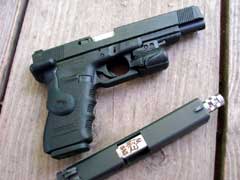
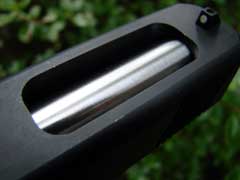
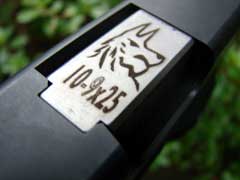
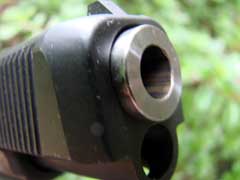
Lone Wolf Long Slide with 6.02- inch barrel.
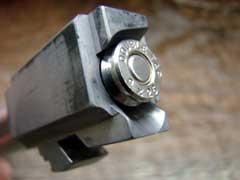
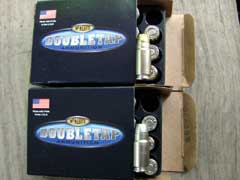
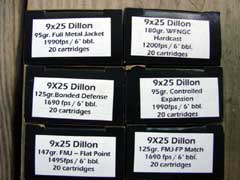
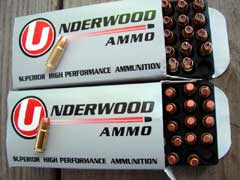
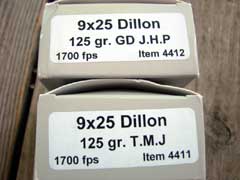
Ammo tested.
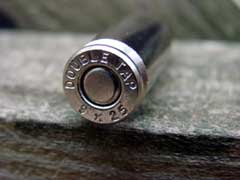
|
![]()